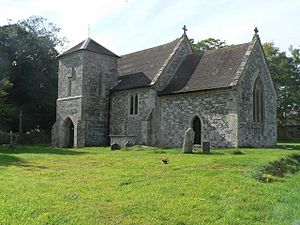St Leonard's Church, Berwick St Leonard facts for kids
Quick facts for kids St Leonard's Church |
|
|---|---|
 |
|
| Location | Berwick St Leonard, Wiltshire, England |
|
Listed Building – Grade II*
|
|
| Official name: Church of St. Leonard | |
| Designated | 6 January 1966 |
| Reference no. | 1318783 |
| Lua error in Module:Location_map at line 420: attempt to index field 'wikibase' (a nil value). | |
St Leonard's Church is a very old church located in Berwick St Leonard, a village in Wiltshire, England. It was built way back in the 12th century, which means it's over 800 years old! This historic building is officially recognized as a Grade II* listed building. This special status means it's an important historical site that needs to be protected.
Today, St Leonard's Church is no longer used for regular church services. It is now a redundant church, which means it has been taken care of by the Churches Conservation Trust. This trust helps to preserve old churches across England. The church officially became part of the Trust's care on June 9, 1976.
Contents
Early History of the Church
In the 12th century, the land where the church stands belonged to Shaftesbury Abbey. This abbey was a powerful religious house. At that time, people from Berwick St Leonard had to take their loved ones to Tisbury for burial. This was because Berwick did not yet have its own burial ground.
Later, different people owned the right to choose the church's priest. This right is called advowson. In the early 1800s, there was a disagreement over who had this right. It was a dispute between John Benett and John Maclntyre, who was a general in the East India Company.
What the Church Looks Like
This small church was built using flint and limestone. These are strong, natural materials. The main part of the church, called the nave, is about 33 feet (10 meters) long and 16 feet (5 meters) wide. The chancel, which is the area near the altar, is a bit smaller. It is about 18 feet (5.7 meters) long and 13 feet (4 meters) wide.
The Tower and Bells
The church's entrance is under a small tower on the south side. This tower was added in the 14th century. It has two parts and is supported by strong diagonal buttresses. Inside the tower, there are two bells. One bell was made in 1725, and the other in 1766. The church roof has a unique pattern, like fish scales, made from tiles.
Inside the Church
Inside St Leonard's Church, you can find old monuments. One of these is for George Howe, who passed away in 1647, and his six children. There is also a round stone font with a brass cover. A font is a basin used for baptisms.
You can also see a stone carving of the Lamb of God above the inside of the south doorway. The stone over the blocked north doorway is also very old. These features, including the font and the carvings, date back to the Norman era. This means they are from the time when the Normans ruled England, starting in the 11th century.
Later Changes and Closure
By the 1800s, parts of the church building were starting to fall apart. So, in 1860, the church was rebuilt. Alfred Morrison paid for this work. He lived nearby in Fonthill Gifford. Even though it was rebuilt, the outside of the church looked mostly the same. The church was officially closed in 1966.
Church Connections
For many years, St Catherine's Church in Sedgehill, which is about six miles away, was connected to Berwick. It was like a smaller part of Berwick's church until 1914. In that year, Sedgehill became its own separate parish.
In 1916, the church leadership of Berwick was joined with the nearby church of Fonthill Bishop. However, the two church areas remained separate until 1966. Today, the church area of Fonthill Bishop with Berwick St. Leonard is part of a larger group of sixteen rural churches. This group is called the Nadder Valley team ministry.
See also

